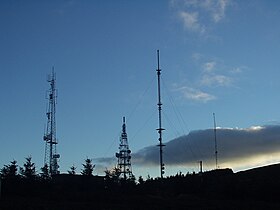Three Rock
| Three Rock Mountain | |
|---|---|
| Binn Trí Charraig / Sliabh Ruadh | |

Masts on Three Rock Mountain
|
|
| Highest point | |
| Elevation | 448 m (1,470 ft) |
| Coordinates | 53°14′43″N 6°14′21″W / 53.24528°N 6.23917°WCoordinates: 53°14′43″N 6°14′21″W / 53.24528°N 6.23917°W |
| Geography | |
| Location | Dún Laoghaire–Rathdown, Ireland |
| Parent range | Dublin Mountains |
| OSI/OSNI grid | O176231 |
| Topo map | OSI Discovery No. 50 |
Three Rock Mountain (Irish: Binn Trí Charraig;archaic: Sliabh Ruadh) is a mountain in Co Dublin, Ireland. It is 444 metres (1,457 feet) high and forms part of the group of hills in the Dublin Mountains which comprises Two Rock, Three Rock, Kilmashogue and Tibradden Mountains. The mountain takes its name from the three groups of granite rocks at the summit. It was once believed that these features were man-made: for instance, Gabriel Beranger wrote of them in 1780, "I take them to be altars upon which sacrifices were offered […] the regularity which is observed in piling them convinces me they are the work of man, as they could not grow in that position". In fact, the three outcrops are tors: natural geological features produced by the gradual process of weathering. Today, the summit is dominated by the many radio masts and towers that use the site to broadcast their signals across the Dublin area below. The forestry plantations on the slopes consist mainly of Sitka spruce, Japanese larch, Scots pine, Monterey pine and lodgepole pine.
The views from the summit are extensive and have attracted visitors for many years. The writer Weston St. John Joyce described the vista thus: “The view from this commanding height, 1,479 feet over sea-level, extends over a vast tract of mountain, sea, and plain, comprising, to the north, the blue waters of Dublin Bay, with Clontarf and Howth, the Naul or Man-of-War hills, and the Mourne Mountains; eastward, Kingstown, Dalkey, and Killiney, and then in succession the fertile vale of Shanganagh, Carrickgollogan, the Scalp, Bray Head, the Sugar Loaves, and the slopes of Prince William's Seat. In clear weather Holyhead and the Welsh mountains may frequently be discerned, Snowdon and the Llanberis Pass being usually the most conspicuous, but occasionally the elongated outline of Cader Idris may be observed some distance to the right". By way of contrast, Gabriel Beranger said of Three Rock, "The extensive summit of this mountain, the parched ground and its solitude, make it the most awful spot I had ever seen".
...
Wikipedia

